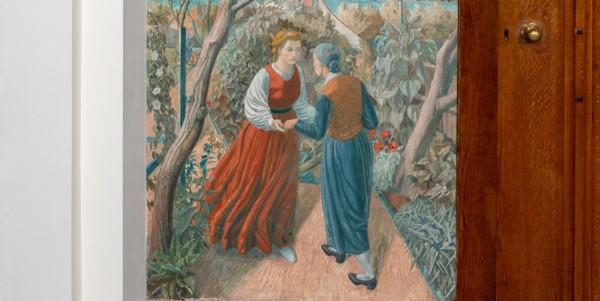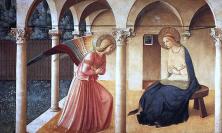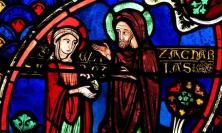In a hidden corner of an Oxford college, James Hanvey SJ finds himself in a space that is at once enclosed and unlimited, and tells the whole history of salvation. Campion Hall’s Lady Chapel, painted by Charles Mahoney, ‘is a remarkably imaginative and creative integration of ancient Marian themes with representations of contemporary life’ – how is this particularly true of the depiction of Mary’s encounter with Elizabeth?
Throughout the Covid-19 pandemic we have come to know the meaning and the consequences of ‘social distance’. At best, we have been allowed to constitute a small group – a bubble – of family or those with whom we normally share our lives. If it is true that ‘absence makes the heart grow fonder’ then there are many hearts experiencing the prolonged absence of physical contact.
This Christmas, how many grandparents are longing to hug their grandchildren and to feel their hugs in response? So much is communicated in a touch that words cannot express. The French Christian philosopher, Jean-Louis Chrétien, suggests that the first evidence of the soul is the sense of touch. And while it is said that hearing is the last of our senses to go in death, touch is surely the first sense we register when we are born. The most natural desire is for a mother or father to embrace their new-born child. That first touch communicates welcome and recognition, it is security and safety, it is the beginning of an independent but connected life. We see it again and again running through all the representations of the nativity, but is it also central in the scenes of the visitation.
Campion Hall, Oxford, was founded by the Jesuits in 1896 when Catholics were permitted to attend the university. In the 1930s it moved to new site and a new building. The hall was designed by Sir Edward Lutyens who managed to integrate the aesthetics of religious life and study with his own aesthetic vision. It moves between a type of classicism, with eclectic touches from his experience of his imperial commissions in India, and the warm humanity of the arts and crafts movement, its textures, materials and forms. The hall is a masterpiece of harmony and generosity, which has proved its value over almost a century of community life.Appropriately, the chapel and the library, linked by the refectory, are the two antiphons that set the rhythm of the hall’s life. The chapel itself is a small masterpiece of simplicity and yet everything leads you visually and spiritually to the altar and the blessed sacrament. Off to the right-hand side as you face them is the hidden jewel of the Lady Chapel.
In the early forties, Charles Mahoney was commissioned to produce a series of panels commemorating the life of Our Lady. He chose to work only with the natural light entering the chapel through the single east window. The work developed slowly and was still incomplete at his death in 1968: his unfinished sketch of the death of Our Lady, who is surrounded by members of the Jesuit community at the time, can still be seen.
Taken as a whole, the chapel is a remarkably imaginative and creative integration of ancient Marian themes with representations of contemporary life, especially the still raw and vivid memories of the First World War (especially in his painting of the nativity). Even if you did not know that Mahoney was a keen botanist and that with another artist, Evelyn Dunbar, he produced a popular illustrated book, Gardener’s Choice, you could not miss the profusion of flowers and plants, in all their seasonal ranges, that form part of the whole sequence of the chapel. It is no surprise that Mahoney, like Fra Angelico, chooses the traditional title of Our Lady, hortus conclusus – a garden enclosed – as his unifying motif. It not only gives him an opportunity to display his own botanical knowledge and delight, it solves one of the problems of a relatively small space. In painting a garden in all its seasons, with the natural structure, colour and form of plants and flowers, Mahoney uses the natural world to ground and illuminate the supernatural realities that fill up the space of faith’s understanding of Mary and the history of salvation that unfolds in her life.
The cold winter deadness that surrounds the nativity with its pallet of dark blues, greys and blacks is not only a natural winter scene. There are soldiers in their heavy winter coats gathered with Mary and the Christ child around a fire. It seems to give light but not much warmth. The coldness is also suggested in the strange static, ‘frozen’, waiting figures; Mary supports the child but seems to gaze beyond him. Indeed, all the people gathered seem lost in their own world. It is intended to echo the tradition of adoration and yet they are not really present. There is no joy, only a sort of ambiguous struggle between the light and the surrounding darkness. This is definitely a wartime scene, even wood and shelter are scarce and barely serviceable. Somehow, the painting carries the memory and the experience of a people already exhausted by the struggle and its after effects. What world is this into which Christ has been born?
Directly opposite are two wonderful panels of spring and summer in which we have children, a garden bursting with life, and colourful flowers and plants. One is the coronation of Mary in heaven – itself now a new garden – and the other is Our Lady, Queen of the Society and Queen of Mercy, serene and with a maternal smile. The most engaging feature of this latter scene are the child-cherubs at the base. While the community is wrapped in adoration within Our Lady’s protective cloak, the child-cherubs are completely indifferent to all that is happening above them. Typical of children, they are absorbed in their own fascinated discovery of the natural world with its thick green foliage and the tactile exploration of the roses. The colour palette moves from those of a sombre, frozen winter to the warm reds, russets, yellows and greens of a full summer in all its barely-contained abundance. There is joy and innocence here, a new timeless time, a garden restored and secured; a world redeemed. Within the relatively small space of the Lady Chapel, these panels speak to each other and they tell the whole history of salvation – a garden lost and destroyed, and a garden restored, bursting with eternal life.
Standing in the space between these two panels, Mahoney has not only confined us within a garden, he has placed us between the two great realities of our faith: the birth of the saviour and the promise of our future glory which we see fulfilled in Mary, Theotokos. Standing in the open space at the centre of the chapel, under a ceiling now become the blue canopy of an open summer’s sky, the garden enclosed has become a garden of unlimited space, an eternity of a nature bursting with life. Here, whether in adoration or the absorbed playful freedom of a recovered innocence, we shall be alive in an utterly new way. No longer exiles from the garden but now at home in it without fear or temptation, rejoicing in the new creation of God’s healing, nurturing love.
Standing in this space, we eventually come to see that it is actually held and defined by the chapel’s altar. It has all of Lutyens’ elegance, simplicity and understated presence. It is not decorative but clearly intended to be used. Without it, even with Mahoney’s creativity and invention, the space would be entirely different. As Lutyens intended, even within the small space the altar is actually the centre and Mahoney does not disturb that. Whether by design or intuition, he allows it to hold the space and quietly unite the deeper realities of which the panels speak. The journey from nativity to glory must pass through the sacrifice of the altar. The action is performed each day, and when that happens the panels are not just works to decorate an empty space, they are acts of prayer and faith.
If the action of the Mass occupies the altar at the east wall, the west wall is also filled with narrative action. In a series of smaller panels it unfolds Mary’s history. Once more we can see how Mahoney’s artistic skill and imagination solves a very practical problem in a completely satisfying and fascinating way.
The problem is the beautiful arts and craft door that links the chapel with the sacristy. By incorporating the wood of the door into a tree/wood motif that runs through several of the panels, Mahoney solves the problem by using the sections which the door and window define to mark episodes in the virgin’s life. This tree tells a story.
We have the birth of the virgin, her betrothal, the visitation, the flight into Egypt and, in the unfinished panel, her death. All the episodes have their own stylistic form. Fashion is as much a mark of period as it is of social rank and character. Mahoney dresses the persons in ways that are contemporary of his time, or the period just before – a remembered time. It is not nostalgia, but it produces a strange effect of another time which is still ‘our time’. The visitation certainly has this feature, for the figure of Elizabeth is dressed as a woman from the 1920s. The practical shoes and the hair reinforce this. Mary is contrasted not only by her maidenly, almost medieval, dress, but she appears to wear slippers rather than shoes. Her hair is light and full, as is her face. Yet, with what eagerness she is coming down the long garden path to meet Elizabeth who, not quite as lithesome, is moving to greet her. They are already clasping each other’s hands in greeting, welcome and in recognition. They have connected, and already in the eagerness and energy which is firmly placed in the foreground we can sense the joy of meeting and of something to be shared.
This kairos meeting is set within the quiet work of caring for the garden. Far along the winding path behind Mary, we can just about see another figure working, and behind the wall of this enclosed garden that rises above Elizabeth we can detect something like a towered building, reminiscent of a village church or country home. The garden itself contains so many levels of time: present, past, remembered, expected, anticipated – all are in this moment. Two women, two different generations, who recognise and understand each other, who care for each other, connect, each of whom has their own magnificent news to share.
Each generation needs the other both to celebrate the gift that each one carries and to proclaim it. Their histories, like their hands and like their sons, are intertwined.
Even in all the movement and joyful greeting we cannot miss the red poppies standing out amid the profusion of green plants and foliage. Such a natural and common feature of a well-planned garden, yet they, too, carry their memory for this generation. They cover the fields of war and in their colour they carry the memory of the blood that was sacrificed.In the early morning light or sometimes in the setting summer’s sun, the chapel is often flooded with light. Like any garden in such moments, it has a luminous quality and we are held in a moment of gratitude for the gift we have been given.
James Hanvey SJ is Secretary for the Service of the Faith for the Society of Jesus, and a former Master of Campion Hall.






